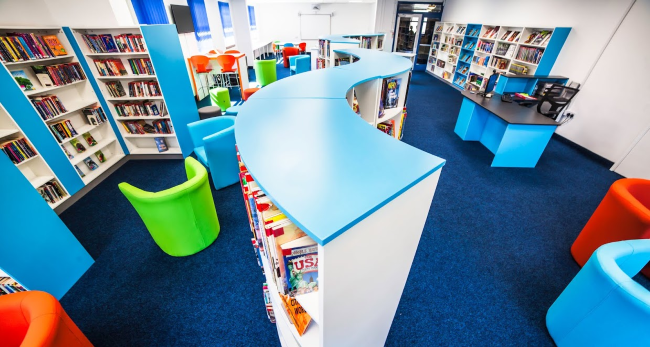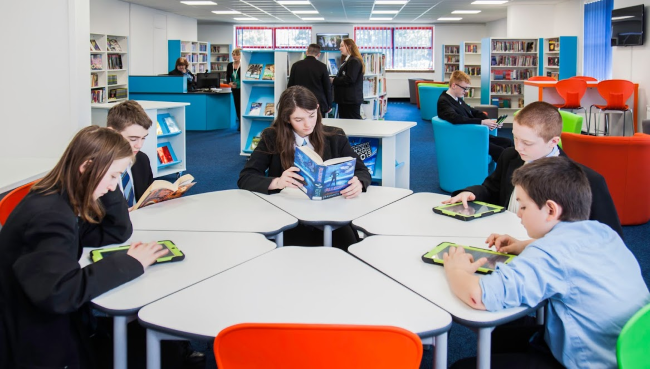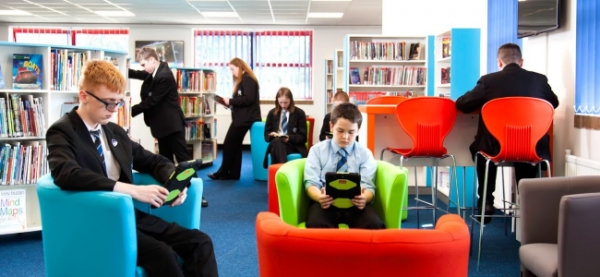As technology’s role in education becomes ever greater and learning moves from a teacher-led model to one with greater emphasis on collaboration and independent learning, the role of libraries has changed dramatically. Often known as ‘learning commons’ they’ve become places where students and teachers can work together, hold meetings, use multimedia equipment and yes, still borrow books.
So how do you go about transforming your school or college library into a space that’s fit for 21st century learning?

1. Shh, listen (to the users)!
It’s important to listen to staff and students when you’re planning any classroom refurbishment or new build. However a learning commons can contain so many different features, it’s particularly important to find out which ones will offer students what they need to improve their learning skills and knowledge. Do they need separate zones or rooms for meetings? A multimedia space with desks for editing and lockable storage for cameras and sound equipment? Seminar rooms with interactive teacher walls or break out areas and café spaces with chairs and tables, breakfast bars and soft, modular furniture?
There’s no such thing as one size fits all when it comes to a learning commons. Think carefully about end user needs now, how they may evolve and how the design of your space will reflect this.
2. Think about the space.
Whether you’re managing a new build or a refurbishment, think about how the space can be used most effectively to engage students of all abilities and interests.
Defined as an environment which fosters learning and communication while encouraging students to meet and engage through exploration, experimentation and collaboration, a learning commons moves beyond the confines of a traditional library, opening up space and introducing technology to create a flexible learning hub.
Incorporating social meeting rooms, breakout work spaces, multi-media pods and poseur bars into your design will enable you to develop a stimulating, visually interesting space which supports a range of student needs – from group working and seminars to individual study to quiet reading areas.

3. Stay flexible.
Adaptability is at the heart of the learning commons: students should be able to alter the space to suit their needs as those needs change, so the furniture and fittings you choose should reflect this.
Incorporating loose chairs and tables, soft modular furniture and reconfigurable mobile shelving units into your design alongside fixed benching and storage will allow you to create subtle yet distinct zones to suit group and individual learning as required. In larger learning commons movable walls and partitions can help to divide the space into meeting and seminar rooms or open it out for group activities.
4. Face the future.
Learning and teaching styles, and technology, are constantly evolving, and the demands students make on a learning commons today may be very different tomorrow. To ensure your new learning commons remains an important feature of student learning, consider the likely changes to the curriculum and where possible incorporate their potential impact into your design.
Desktop computers are declining in use and the adoption of mobile devices is on the rise – would individual pod benching for quiet work and poseur benches with plasma screens to view group projects be a better choice than rows of benching to house computers? Ensure plug sockets are plentiful and students won’t have to struggle to charge up their devices. A learning commons should be a space that can be reconfigured to suit the needs of its users, so it’s important to ensure it’s well lit.
Durability as well as flexibility is essential when choosing furniture for a learning commons: opt for desks, tables, benching and storage made from hardwearing, easy to maintain materials and you’ll ensure they meet the demands (and reconfigurations) of generations of learners to come.
5. Inspire.
A learning commons isn’t just another term for a library – it’s much more than that. Many students feel alienated or excluded in the highly academic library atmosphere of silent study and research. The learning commons aims to appeal to students of all interest and abilities, engaging them by offering an environment that appeals to their individual learning styles.
Good use of colour, light and space and providing students with the options to work in groups, use technology or simply read a book helps to create an atmosphere that appeals to even the most reluctant learner, recruiting, retaining and ultimately rewarding them by building their knowledge and life skills.
Photos: Abertillery Comprehensive School, Gwent
Have you implemented similar strategies in your school? Let us know in the comments!


















